76 trombones led the big parade! With 110 company players right behind! Well…maybe not 110 (just 54 including the savvy, slick-talking Professor Harold Hill himself) but the way they sing, dance, and move all around that stage in the Sacred Heart School auditorium it sure feels like 110 of ‘em! Egads! Whaddya talk? Whaddya talk? Whaddya talk? Well I’m talking ‘bout a music man! A music man? No— The Music Man! And it’s riding the Wells Fargo wagon right into the middle of Glyndon as The Glyndon Area Players finally get to present this long-awaited classic show. (It’s been on the books since 2020, you know…) and now it’s here! Directed by the incomparable Homero Bayarena with Musical Direction by Samantha Grimes (vocal) and G. Scott Barton (orchestral) and Choreography by Lori Maccia, this hallmark of yesteryore theatre is a nostalgic romp through simpler, happier, musical times and GAP is swerving it up swell!
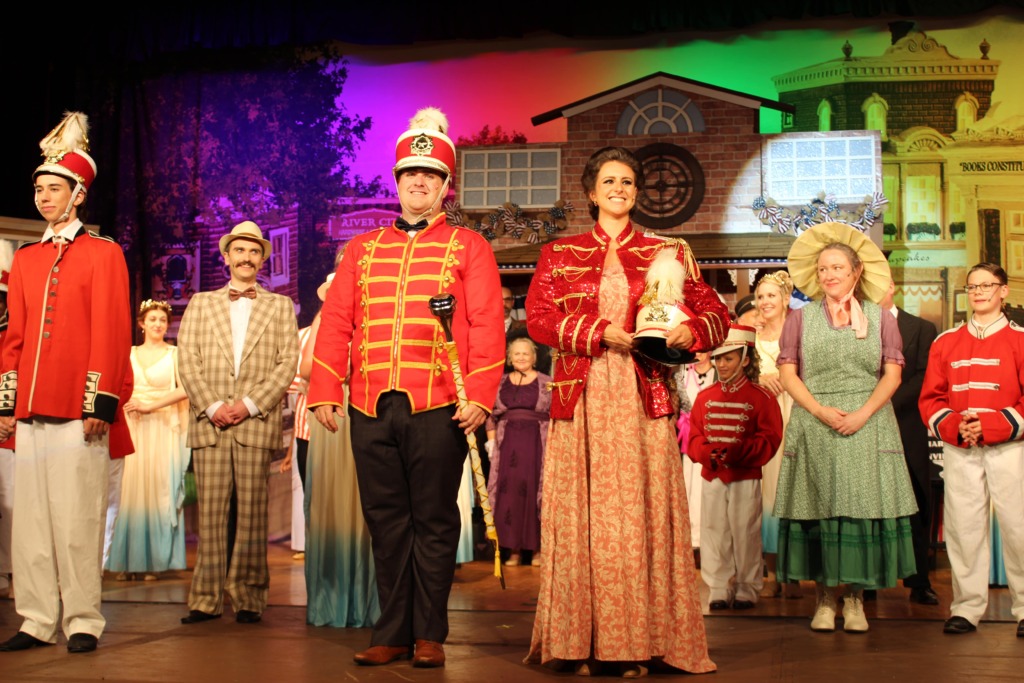
River City, Iowa has rolled into the auditorium in the most theatrically magical way possible. Set Designers Homero Bayarena and Michael Parks (and a build-team that’s probably made of 110 cornets right behind…) have pulled out all the stops. You’ve got a beautiful backdrop that creates the basis for their vision and then you’ve got tremendous, rotating structures that present front-facing sides of various shops and stops in town as well as building and house interiors once they’re rotated around. They’ve even got full-on train carriage with pew-bench compartments and paper-crinkle window shades! It’s all of the attention to detail that Bayarena and Parks give to the set that make it extra special. Bayarena, Parks, the build team, and their scenic squad add personalized touches to the town of River City as well. There’s a hand-pained sign that says ‘Dunlop’s General Store’ and ‘Squires’ Livery’ and a really faded sign that looks like it might say ‘Shinn’s Billiards.’ The scene in the library (which is the backside of townhall) has two-tiers to play with and ‘stained glass’ windows! One could readily go on and on about all the beautiful detailing just in the set alone— like the old-fashioned screened-porch door with the wooden accents to intersect various sections of the screen on Mrs. Paroo’s back porch. Or the extraordinary, practically life-sized Well’s Fargo Wagon that comes rolling right up the center aisle of the house to deliver those band instruments at the end of Act I; it’s truly a wonderful sight and really engages the audience as a whole in the production.
Matching the set detail for detail (and giving this particular reviewer the worst case of hat-envy she’s ever had) Costume Designers Homero Bayarena, Kari O’Donnell, Elaine Bayarena, and Susan Zepp gather an assortment of 1912 period dresses that look simply smashing on all of the ladies, both young children and more mature alike, all over River City. It’s a most colorful collection (you’d think they were still channeling their technicolor Dreamcoat energy from last season there are so many colors!) And patterns too— florals, stripes, solids, checker-plaid— the couture for this show has it all. Including a delightfully ugly and completely appropriate for the time period autumnal mustard-checkered suit for Marcellus; you won’t lose him in a crowd! The Barbershop Quartet as they come to be recognized, even get proper red and white striped vests for one of the big celebrations. You’ll be on visual overload for days between the set and the costumes, making you want to see The Music Man twice so that you can catch all of the amazing nuances featured all throughout the show.
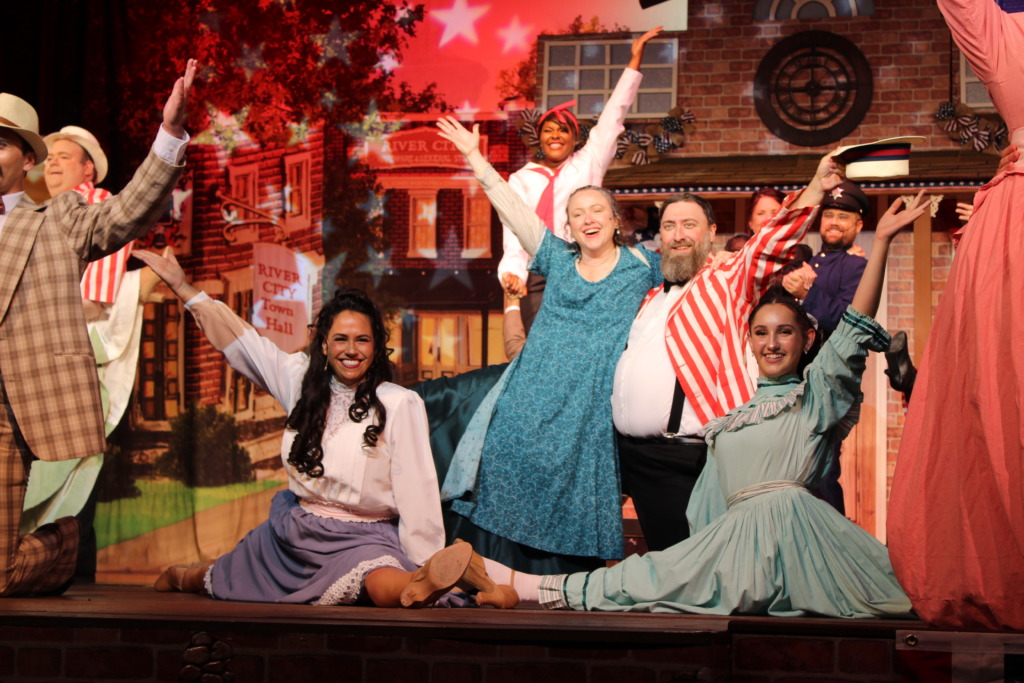
Lori Maccia may not be the Wells Fargo Wagon, but she sure is bringing something special just for the audience with all of her enthusiastic, energetic, and well-maintained choreography. Assisted by Amanda Polanowski, this Choreographic Duo has the style and rhythm of the music matched perfectly into dance moves of the times. The Music Man situates itself in a time before fist-pumps, crazy floor spins, (when there were only 48 states in the great union of America…) and many of the more modern moves that get musical-theatergoers excited about watching the dance-breaks of songs. But Maccia and her assistant do not disappoint! They fill the dance breaks, particularly for “Marian the Librarian” and “Shipoopi” with lots of energetically enthusiastic moves that fit the time. There’s turning and twirling, cake-walking, and a balance of people on stage. The GAP stage is large; the scenery is larger and the number of people that populate the ‘entire ensemble’ scenes is larger still. Maccia finds exceptional balance to rotating groups of dancers in and out— particularly during “76 Trombones” and “Shipoopi” in a way that flows naturally and doesn’t read like she’s rotating groups of dancers in and out of the center-stage focal point. It’s a myriad of nostalgic moves that throwback to a simpler time in America’s past, give a nod of homage to the show’s cinematic origins, and is aesthetically pleasing to watch every time the company breaks out into a dance.
Unsung heroes of the production include The TD Team— Tech Directors Scott Molony, Tom Zepp, and Michael Parks— Stage Manager Karen Janiga and Backstage Manager Michael Fronheiser (one among them must be keeping an eye on those dozen or so River City youngins’ and they’re doing a fantastic job of it!), and Sound and Lighting Designer Charles Hirsch and Jim Shomo respectively. The sound is well-balanced (you have an unmasked, live orchestra pit directly to the front and side of the stage and yet hearing the singers over or with the live pit is never an issue) and the lighting blends as it should into the show’s moving aesthetic. You have one or two moments where Shomo gets a little fancy, showing off some star-light projections, but they’re perfectly suited for the moments wherein they are utilized. It is evident that the Technical Team and run crew of this show really have a seasoned handle of how to keep a show on its tracks, moving as steady as that train in the opening number!
Now we mentioned the orchestra* and how well-balanced they were. Under G. Scott Barton’s direction, all of the iconic tunes from the overture, through the entre’act right through the curtain call float along bubbly and mellifluously. With a pit of 15, the sounds are resplendent, and they keep perfect pacing with all of the musicians on stage. Some of the numbers settle back into a pace that might be a half-step behind the way its written, allowing for the audience to better hear some of the fast-paced patter rolling out of songs like “Trouble” and “Sadder But Wiser Girl” whereas numbers like “76 Trombones” and “Shipoopi” sound exactly as one remembers them. It’s a great sound to be heard and Barton is a good and proper music man, leading his band to great success.
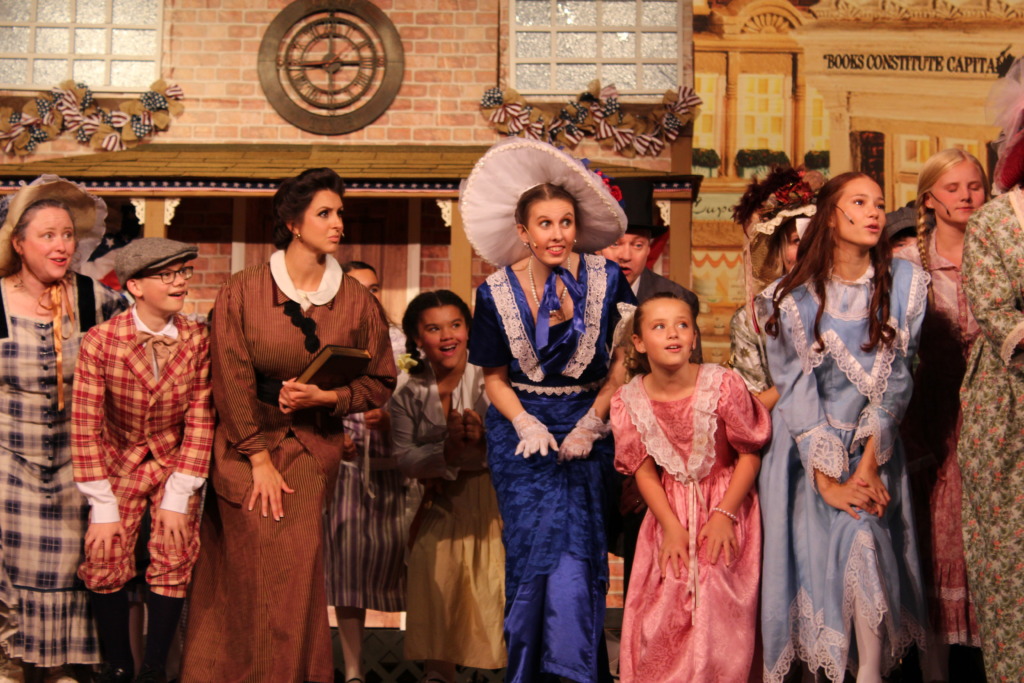
The other music man— well, music woman in this case— Samantha Grimes, is serving as the show’s vocal coach and she’s soaring through that job with flying colors. With so many people on stage it can be easy to lose the harmonies, the blends, and the articulation of words— but not on Grimes’ watch. She ensures that each number has all of its harmonic components in place, especially when it comes to the Quartet of Gentleman. Their classic quartet blend during numbers like “Sincere” and “Lida Rose” are musical magic. And the cheep-cheep-cheeps that pop out during “Pick-a-Little, Talk-a-Little” actually sound gracefully rather than the shrieking, clucking sound that so many productions defer to for this particular number with the Pick-a-Little ladies. Grimes is a testament to the caliber and quality of musicality when it comes to productions at GAP; the sound of this show is as impressive as the visuals.
Homero Bayarena wears many hats in this production— we’ve mentioned several already, and let’s not forget the role of Train Conductor (which involves an actual hat!) where he hollers bombastically for River City, Iowa to be the next stop of the train. (It’s a cameo role but it’s a gosh-darn cute one!) There’s intention behind the way Bayarena sets out to direct the show. The choreographer can have people moving with intention and purpose because the moves and the music of the dance routine make it so, but Bayarena makes magic during fully populated town scenes. No one appears to be just standing there, even when they’re just standing there. You get the sense you’re watching an actual town absorb, react, and respond to the things that are happening around them. This approach to directing is what sets this production of The Music Man apart from others and elevates it above the preconceived notion of ‘community theatre.’ Everyone has a moment, some have several, where their individual townsfolk or town-child character gets to shine and be themselves and you could spend every production picking out a different moment to enjoy and never see the same moment twice. Bayarena gets a nod of double praise for his wholistic inclusion with this production as well. Leading into tech-week, one of the ensemble members broke their foot and would be unable to continue performing due to the injury. In a plenty-packed ensemble it would have been easy enough to take the loss, but Bayarena (with the assistance of cast member Colleen Esposito) found a clever solution and put the cast member in an antiquated (think FDR in Annie) style wheelchair and assigned various ensemble members to help wheel this cast member on and off during the ensemble scenes. It speaks volumes about the commitment and dedication to the performers as well as the performance when a situation like this occurs and the director is able to find a quick, inclusive solution.
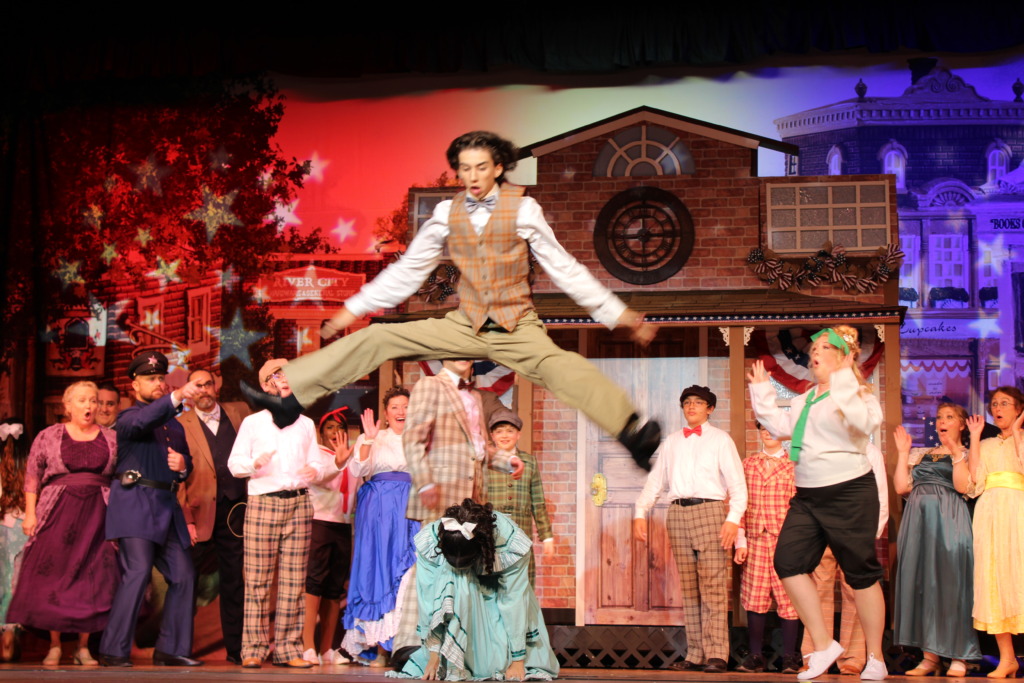
Where does one even start with all 110 performers? The River City Kids, of course! Featuring Nellie Angerer, Favour Ashekun, Ava Grant, Claire Jabaji, Marcus Jones, Beckett McIntyre, Connor McIntrye, Sawyer Moore, Seeley Moore, Angel Oka, Vivian Page, and Gavin Rios, these River City kids can be seen all throughout the production whenever there’s something going on in the town. And they look too cute for words when they come out with all of their little instruments in their band uniforms at the conclusion of the show; it’s precious and priceless! Among the youngsters are the ‘named youth’ of River City, including Jesse Skidmore as Noah and Claire Case as Evaline, Lia Molony as Gracie Shinn, the Mayor’s youngest daughter. And let’s not forget syrupy-but-sassy Amaryllis (at this performance Hannah Igla, though the role is split and shared with Trista German.) Igla, as the young girl who takes piano lessons with Marian, has a lovely voice that pairs well with Marian during their floating duet, “Goodnight, My Someone.”
The aforementioned Winthrop (Jackson Page) is just adorable and almost too cute for words! Silent and stubborn right up until he gets the hope of playing in the boys band, Page is a precocious youngster who gets a good handle on the character’s lisp. (It’s an integral part of the storyline as to why he doesn’t talk much.) And his eyes light up when he points out that the Wells Fargo Wagon is coming; his verse in that number is delightful as is the way he busts right out into “Gary Indiana”, a song with hardly any ‘s’-s in it! Watch Page near the end of the show in the confrontation with Harold Hill, it’s truly very endearing.
You’ve also got Tommy Djilas (Max Ryon) who is spunky and plucky and well, Jeely kly! If he isn’t ever a swell dancer! Ryon’s Tommy Djilas pairs off with Zaneeta Shinn (Gray Jabaji) for “Shipoopi” and the pair really show us how its done. Egads, they’re terrific together and their meet-cute chemistry is just adorable. Of course, the more adorable they are, the more conflusterated, fabblabbergated, confoundit—I guess I better watch my phraseology! Point is— cuter them two are, the more irate Mayor Shinn (Hugh Carson) gets. Watching Hugh Carson bluster and blowhard all throughout the performance is quite the laughable affair, particularly when he’s bumbling and stumbling over the correct phraseology (again, scripted that way) whilst trying to blow his stack at various people in the town, including his wife. Whenever he gets into ‘conspiratorial mode’, gathering the four members of the school board to him, demanding they get Hill’s credentials, there’s a hilarious callback moment where Jim Gross’ character is right up in his face but Carson doesn’t notice until he turns his face and then has this gasping, taken-aback surprise moment. And the more it happens, the harder the audience laughs at the antics of it.

As for the mayor’s wife, you’ll laugh yourself silly at the portrayal of Eulalie Mackecknie Shinn (Lori True) and all of her over-the-top caricature shenanigans. Everything from her overly exaggerated dance steps to the way she enunciates certain words, it just has you laughing, and her facial expressions will have you laughing so hard, your side will hurt! But what’s a ‘first lady’ without her sidekick squad? And Lori True’s Eulalie has a quartet all their own. Ethel Toffelmeier, Alma Hix, Maud Dunlop, and Mrs. Squires— played by Colleen Esposito, Azaria Oglesby, Deborah Carson, and Natalie Beller, respectively— and they are a real comedic scream. Particularly when they’re being lead through their ‘dance exercises, with balancing the books on their head? Deborah Carson’s Maud Dunlop just gives up, goes crazy and starts doing her own thing with the book. They all have precious moments of hilarity— particularly Colleen Esposito, who is the ‘nice girl that Marcellus finally settled down with— and they’re just a delight to tickle the funny bone every time they’re on stage. Esposito also has a fine set of dancing skills to showcase, particularly when she and Marcellus Washburn (Henry Cyr) get to kicking up the floorboards in “Shipoopi”.
You’ve got the quartet of silly ladies amid all the River City Ladies, and they are the featured women who sing out during “Pick-A-Little, Talk-A-Little” but there’s a whole group of gals featured during that number— Rachel Bagley, Sam Brady, Cheryl Degenhardt, Sonnda Feher-Hesen, Cassie Little, and Tyson Stahl. And under Samantha Grimes’ vocal guidance, the song is actually lovely to listen to, and the words are articulated clearly. These ladies, when not tattling their tongues with gossip about the poor town librarian, can be found mingling with the rest of the Ladies of River City (Karen Curtis, Jayden Frisby, Tyler Harris, Nacy Heim, Molly Kelsh, Kelly Kluka, Lori Maccia, Addy Molony, Jodi O’Connell.)
Now you may have noticed some doublin’— right here in River City! That’s because you’ve got people of talent and that starts with ‘T’, which rhymes with ‘P’ and that stands for pool! Ike the Rock Island Salesmen (Neil Beller Jr., Jonathan Deane, Matthew Alford, James Botelle, Henry Cyr, Jim Gross, Seth Hench, Scott Molony, Josiah Nusbaum) who rattle and bounce their way through “Rock Island” with a bouncing physicality to simulate the rumbly, bumpy train line so effectively that you start bouncing along in the audience! But you’ll note that the primary bounce-speak-patter-persons in that number are Cyr and Nusbaum, and while Nusbaum stays as Charlie Cowell, the mean-spirited, nasty skunk of an anvil salesman who takes a fly-sliding shove at one point (resulting in a huge gasp from the audience!), Cyr doubles up as Marcellus Washburn, singing and dancing and jiving and plotting along with Professor Harold Hill. Same with some of the other salesmen on the train.

The four harmonious noteworthy salesmen are of course the Barbershop Quartet members— Oliver Hix (James Botelle), Olin Britt (Matthew Alford), Ewart Dunlop (Jim Gross), and Jacey Squires (Seth Hench.) Now the quartet of men sound beautiful right from that first blend of “Ice Cream” that Harold Hill gets them singing. But the one to watch is Jim Gross, largely because he’s grumpy and grumps the entire way through the production, except for later on in the performance when someone convinces his character to try and smile; the result is uproarious and hilarious. Watch Gross literally haul one of the River City kids away over his shoulder during “Trouble” too; it speaks to the character he’s built within this quartet member. All four of the quartet— Botelle, Alford, Gross, and Hench— have striking voices that just burble and bounce along with one another the way an old-fashioned Barbershop Quartet should. “Lida Rose” becomes this hypnotic lullaby under their careful musical ministrations.
Plucking up her most Irish of accents, and kicking her feet in a hilarious gleeful moment, Suzi Eldridge plays the role of Mrs. Paroo with vigor and vim and a whole bunch of attitude. There’s only the one real moment in dueling duet song with Marian where Eldridge gets to showcase her vocals solo, but the way she patter-sings through “If You Don’t Mind Saying So” is really fun and agreeable. Eldridge’s sense of comedic timing is spot-on too, particularly when snapping back at Marian about flint and steel in separate drawers, as well as when she cackles with glee about using the “think system” on Marian from the parlor.
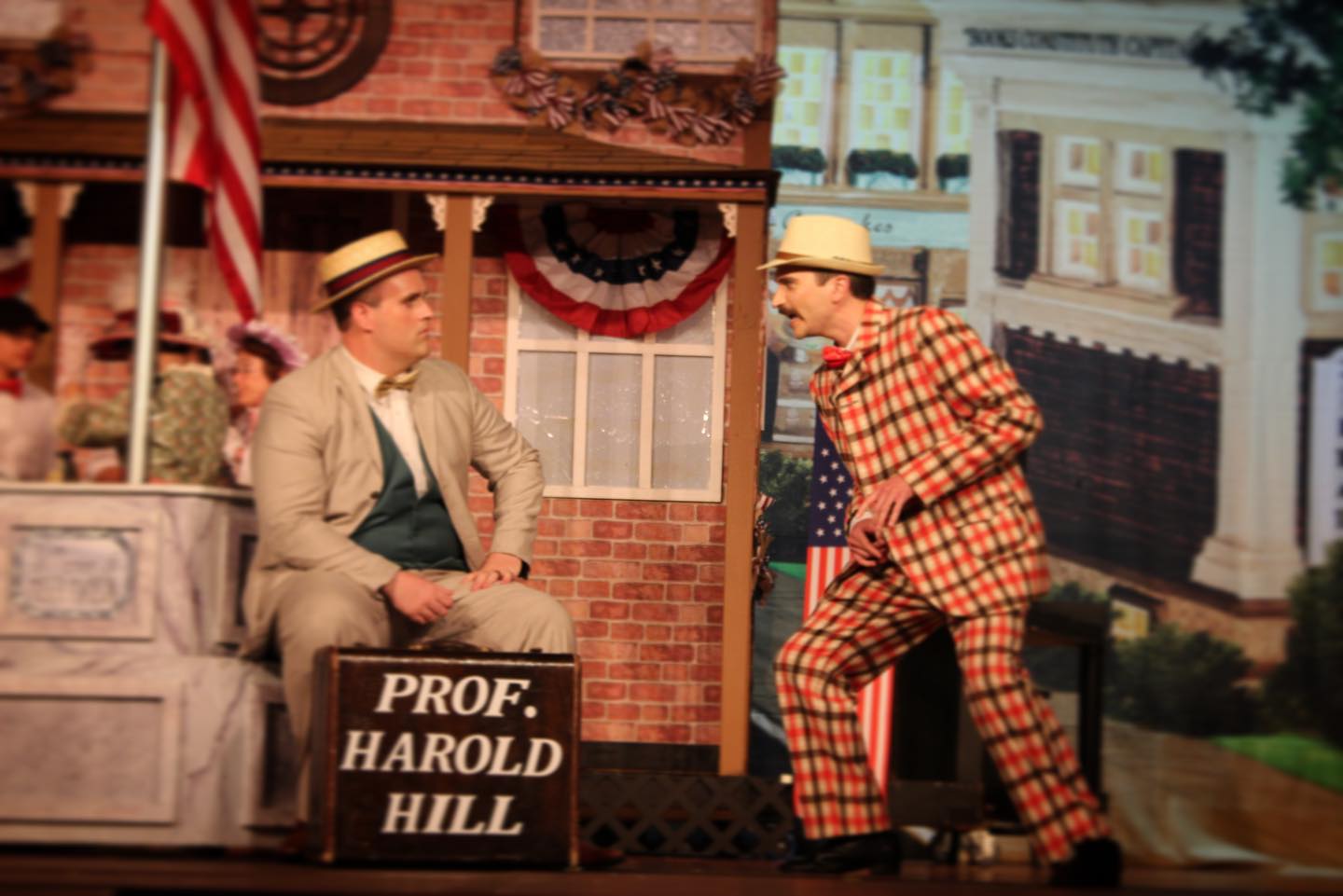
We’ve mentioned Henry Cyr a number of times over now, the slick on his feet, fancy-footed dancing Marcellus Washburn, and of course as the patter-master during “Train Opening/Rock Island.” But its when he’s living in the Marcellus character, playing directly opposite Tom Zepp’s Harold Hill that you get the most lively, animated performance out of him. “The Sadder But Wiser Girl” all but transforms Cyr into some sort of live-action motion-bound puppet as he leaps, spins, and whirls through that number with Zepp. He’s got a great sense of stage presence, knowing when to make he cameo moment pop verses when to blend flawlessly into the background. And he’s got a stellar voice that supports those moments in song with gusto.
Winsome, gloriously sweet, and terribly frosty Marian (Samantha Grimes) is the perfect blend of wholesome operatic soprano, alighting on those melodious and iconic numbers with her tremulously beautiful soprano sounds, and being the frigid, pinched, frosty ‘near-spinster’ who wants absolutely nothing to do with that clap-trapped, smooth-talking salesman Harold Hill. The facial expressions alone on Grimes, particularly when she’s glaring at Harold Hill, are hysterical. Everything from her rigid posture to the way she struts away from him and skirts around the gossipy, gabby townswomen gives every indication that she is the cold, clinically detached town librarian. But you see this beautiful, softer side of her, particularly when she interacts with Winthrop, and whenever she graces the audience with her stupendous sound. The musical arc of her character, starting with “Goodnight My Someone”, crescendo-ing through “My White Knight” and concluding with “Till There Was You” is an extraordinary and graceful journey explored with rich emotions in Grimes’ capable vocal wheelhouse. She finds the best of both worlds in the Marian character and blends it together sublimely. The cheeky refusals she is perpetually throwing at Harold Hill make their ‘at-last’ reunion moment that much more rewarding.
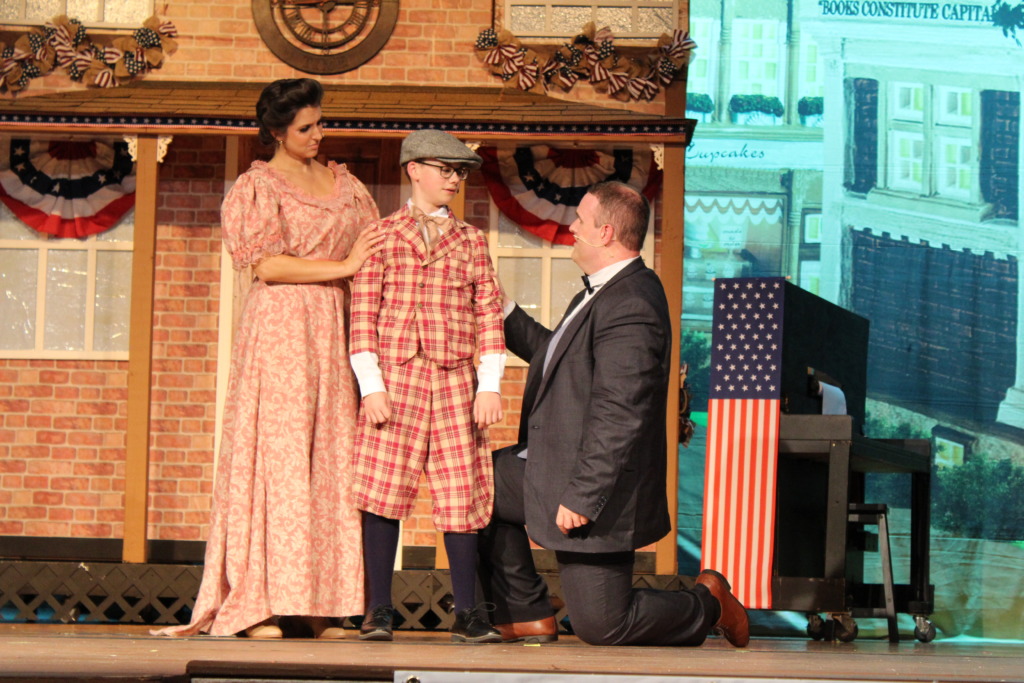
The salesmen at large may insist that ‘he doesn’t know the territory!’ Though Tom Zepp, in the titular role as Prof. Harold Hill the ‘music man’, is no stranger to the territory of musical theatre. While not as smug or conniving as some may remember Harold Hill being, particularly when he first oozes into town, you get that classy charm that’s an intrinsic effect of all salesmen when Zepp hops off the train staking his claim of “I’ll give Iowa a try.” With a wondrously deep, and mesmerizing sound, the moments that Zepp spends in ballad, singing opposite Marian, are truly remarkable. He holds his own pattering his way quickly and effectively through “Trouble” and to a lesser degree “76 Trombones.” You get a great sense of his blended vocal capabilities during “Marian the Librarian” as well. And when he takes to the dance, Zepp is keeping in step with all the youngins of River City just like he was one of them.
Glyndon Area Player’s The Music Man is a delightful romp down memory lane, inspiring robust and hearty moments of nostalgia at every turn. There’s so much lively enthusiasm and little character moments happening with all of the players on stage, it’s a visual, aural, and emotional feast which one can really sink their teeth into! A pleasurable and joyful experience, don’t miss The Music Man this August with Sacred Heart’s Glyndon Area Players.
Running Time: 3 hours and 5 minutes with one intermission
The Music Man plays through August 13th 2023 at the Glyndon Area Players in the Sacred Heart School Auditorium— 63 Sacred Heart Lane in Glyndon, MD. Tickets are available at the door or in advance online.
To read the interview with Samantha Grimes and Tom Zepp, playing Marian and Harold Hill, click here.
*under direction of G. Scott Barton including Rachael Daudelin, Matt DeBeal, and Danielle Gallina on violin, Sharon Aldouby, Alice Brown, and Carrie Price on cello, Larry Brown, Mary Haaser, Cathy Nusbaum, Cindy Suchanek, Cyndy Wachob, and Ed Wender on reeds, Steve Anderson, Jim Biddle, Carissa Hench, Karen Soper, Bo Weaver, and Cassie VanScoyoc on brass, Debbie Gonio and Lori Anderson on piano, and Andrew Trainer on percussion.
